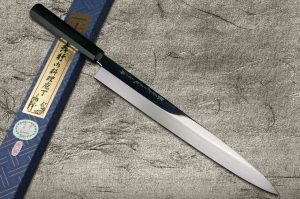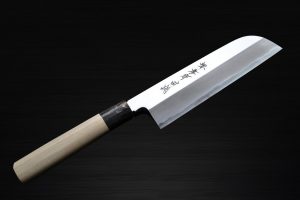Sakai Takayuki TUS Steel Japanese Chef’s Gyuto Knife 180mm
img by : https://www.hocho-knife.com/
Japanese cuisine is famed for its delicate components and subtleness portrayed in the way dishes are served, unique ingredient combinations, and the mastery of the blades. For decades and even centuries, Japanese dishes are intricately prepared, using available resources like seafood and veggies, but were preserved in various traditional ways to keep food edible for longer periods of time.
As time goes by, preserving fish through marination and the use of salt in the process have introduced the world to a wonderful, truly unique dish – sashimi. Sashimi is a dish which consists of raw fish fillet and sliced into beautiful pieces, placed on a Japanese traditional plate, showcasing the abundance of the resources fresh from sea. Often served without rice, sashimi comes plainly, yet is loved by diners from all parts of the world. Sushi, on the other hand, is a dish which consists of raw fish, seafood, or poultry toppings placed on beautifully formed, cooked Japanese rice mixed with vinegar, sugar, and salt. These two Japanese delicacies were introduced to the culinary industry since the 1700-1800s and have transformed into modern-day famous dishes loved by gourmets worldwide.
With delicacy and intricacy being two important terms that best describe Japanese food, specifically sushi and sashimi, Japanese food chefs and professionals are always in the search for premium-quality equipment to successfully craft Japanese delicacies and fully enhance their skills and techniques. Japanese cutlery, or Japanese knives in general, are usually expensive, offered in extremely high prices due to premium-quality hard steels like those of the famed Aoko Blue Steel, White Paper Steel, Super Gold 2 Steel, High Prime Carbon Steel, and other kinds of stainless steel used in the forging processes of Japanese knife making.
Forged to be extremely sharp out of the box, high-end Japanese knives are required in all intricate cooking processes handled by culinary experts to make hand-crafted delicacies served in luxurious, authentic Japanese restaurants. There are a wide variety of knife types used by experts in the culinary field to craft delicious, mouth-watering dishes, of which include: Gyuto, Santoku, Yanagiba, Sujihiki, Deba, Nakiri, Deba, Bunka, and others. Among the latter, a Gyuto knife or also known as a multi-purpose knife, is widely used to perform numerous skills and finish-off a wide array of tasks.
A Gyuto knife is an all-round, multi-purpose knife and indeed a must-have cutlery in a kitchen. A Gyuto knife is usually narrow in blade body, equipped with a slim cutting part alongside a pointed edge. Suitable for varying uses, most people call the Gyuto knife a ‘Chef’s knife’; its capabilities include basic cutting, chopping, slicing, and even filleting (basic filleting, not to be compared to using a Yanagiba knife). A Gyuto knife can cut, slice, chop all kinds of ingredients: fish, veggies, poultry, and fruits. With this, most Japanese food aspiring chefs or beginners would start their training with the Gyuto.
Sakai Takayuki’s TUS Steel Japanese Chef’s Gyuto Knife
Among the top Japanese knife brands, Sakai Takayuki offers knife users wide range of series and models forged with top-quality hard steels and premium-grade handle materials. Among its best-selling Gyuto models, the TUS Steel Japanese Gyuto knife is loved for its extreme blade sharpness, durability, high performance, rust resistance, stain resistance, and affordable price. Offered to aid users in all kinds of food preparation processes that involve traditional and modern techniques, Sakai Takayuki TUS Steel Japanese Chef’s Gyuto Knife 180mm is definitely a must-have in the kitchen. Forged with high carbon stainless steel manufactured by Aoki Hamono Co, users are guaranteed quality and efficiency without doubts.


